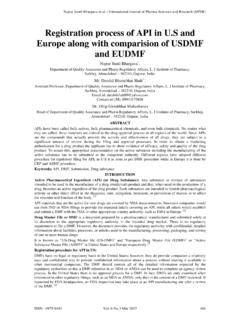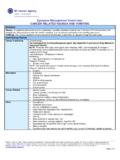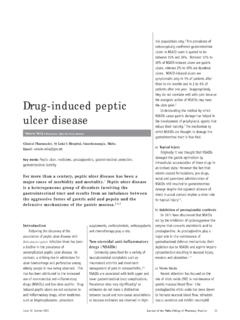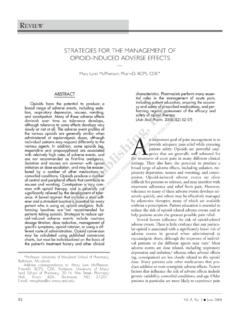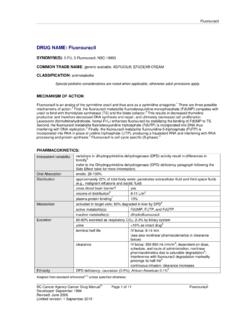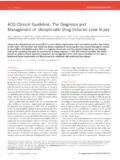Transcription of CALCIUM CHANNEL BLOCKERS INDUCED …
1 CALCIUM CHANNEL BLOCKERS INDUCED peripheral EDEMA Kamala Sangam, Pragathi Devireddy, Venkateswarlu Konuru* Department of Clinical Pharmacy and PharrmD, St. Peter s Institute of Pharmaceutical sciences, Kakatiya University, Warangal, Rohini Super Specialty Hospital, Telangana, India E-mail: ABSTRACT Purpose: To evaluate the onset of CALCIUM CHANNEL BLOCKERS (CCBs) INDUCED peripheral edema (PE) by taking time gap (date of initiation of drug to date of withdrawal of the drug due to ADR) into consideration. Method: A Prospective and retrospective pilot study was conducted in tertiary care centers and patients on CCBs therapy who has experienced peripheral edema were enrolled. The information collected includes: Drug, Time gap, Drug management, ADR management, WHO s probability scale and severity of ADR.
2 The information obtained was analyzed by calculating Mean, standard deviation and P value using Fishers exact test. Results: Total 700 ADR s were reported in them 46 ( ) were CCB s INDUCED PE, among them 27 ( ) amlodipine and 19 ( ) nifedipine INDUCED PE. The study shows patients with age (years) (64 11) amlodipine, (56 13) nifedipine and P= , within them males were 26 ( ).Based on time gap there is a significant difference between Amlodipine ( ) and Nifedipine ( ) and P= Drug management in patients experiencing ADR due to amlodipine (n=20) drug withdrawn and Nifedipine (n=12) drug withdrawn. ADR management of patients taking amlodipine (n=11) specific, (n=10) symptomatic and Nifedipine (n=15) nil.
3 WHO s probability scale in patients taking amlodipine possible (n=7) and nifedipine (n=19) probable. ADR severity due to amliodipine moderate (level3=10,level4=5) and nifedipine mild (level2=17). Conclusion: The incidence of PE due to CCBs is high, there is a significant difference in the time gap between amlodipine and nifedipine. Before initiating the therapy patient should be counselled regarding the risk of PE and immediate physician consultation. Key words: CALCIUM CHANNEL BLOCKERS , Adverse drug reaction, peripheral edema. INTRODUCTION CALCIUM CHANNEL prevent CALCIUM from entering cells of the heart and blood vessel walls, resulting in lower blood pressure. CCB S are also frequently used to alter heart rate, to prevent cerebral vasospasm, to manage migraine, in Raynaud's disease and to reduce chest pain caused by angina pectoris.
4 Various CCB S include Diltiazem, Felodipine, Amlodipine, Isradipine, Nifedipine, Nicardipine, Verapamil. Common ADR S of CALCIUM CHANNEL BLOCKERS include:headache, constipation, rash, nausea, Hot flushes, edema (fluid accumulation in tissues), drowsiness, low blood pressure and dizziness. [1] The combination of a CCB and an angiotensin receptor blocker (ARB) are the best option in hypertension management.[2][3] is effective in reducing BP in hypertensive patients.[4] When used as monotherapy, CCBs are associated with a substantial risk of peripheral edema,[5] including ankle edema, is a recognised adverse effect of the CALCIUM CHANNEL blocking agents which may reduce usefulness, particularly in an aging population who have co-morbidities.
5 If Ankle edema is mild or severe it can affect quality of life of patients. Ankle edema is developed mostly in women, elderly patients, those with heart failure, upright position, and those in humid environments ankle edema is a class effect in all CCBs, there are differences in the incidence of ankle edema between the different classes of CCB S, with edema more likely with the dihydropyridine agents. The incidence of ankle edema has been reported as ranging from 1-15% in patients treated with DHP agents. Within the DHP group, those that are membranophilic , may have lower incidence of ankle edema. Ankle edema is mostly dose related, and its incidence may exceed 80% in patients taking long term high doses of DHP agents.
6 CCB- INDUCED edema is caused primarily by the increased capillary hydrostatic pressure that results from greater vasodilation of pre-capillary than post-capillary vessels. This effect may be mediated, in part, by greater sensitivity of resistance vessels may lead to CCB- INDUCED reductions in myogenic vascular reactivity, may be augmented by CCB- INDUCED decrease in postural vasoconstriction. Because the edema is related to the mechanism of action of dihydropyridine CCBs, it represents a class effect. Thus, although differences among CCBs in edema incidence rates have been reported in a number of studies, it is evident that dose-dependent peripheral edema remains a common side effect in patients receiving both established and newer CCBs.
7 [6] CCBs are used as antihypertensive drugs, Common ADR of them is peripheral edema (Up to ), with amlodipine Incidence is Up to [7] and with nifedipine Incidence is 7% to 29%. Kamala Sangam et al. / International Journal of Pharma Sciences and Research (IJPSR)ISSN : 0975-9492 Vol. 7 No. 6 Jun 2016290 MATERIALS AND METHODS A Prospective and retrospective pilot study was conducted in tertiary care centers. The ADR s in our study were collected from the ADR s which are documented in the department of pharmacy practice. The patients on CCBs therapy and reporting peripheral edema were enrolled in our study. The information collected includes: Drug, Time gap, Drug management, ADR management, WHO s probability scale and severity of ADR.
8 The information obtained was analyzed by calculating Mean, standard deviation, P value using Fishers exact test. RESULTS AND DISCUSSION Total 700 ADR s were documented in the department of pharmacy practice. Out of them 46 ( ) patients were CCB s INDUCED PE, among them 27 ( ) amlodipine INDUCED and 19 ( ) were nifedipine INDUCED PE. The patients were distributed according to their sex in both amlodipine and nifedipine and their average age was calculated in both the details were shown in Figure-1: Based on age & gender distribution of ADRs The above figure explains that there is no age difference between patients with PE taking amlodipine ( ), nifedipine ( )where P= which is similar to Makani H[8] study where One hundred and six studies with 99 469 participants, mean age of (56 6) years, has satisfied our inclusion criteria and were included in their Among 46 patients with PE, females were 20 ( ), males 26 ( ) and P= which is similar with Harikrishna Makani[9] study where 55% were is no difference between male and female.
9 Estimation of time gap, , the period between drug intake and onset of ADR. The time gap is calculated in both the groups and details were shown in Table-1: Distribution of data based on time gap DRUG TIME GAP (DAYS) P value Amlodipine Nifedipine The above table explains that there is a significant difference of time gap between amlodipine and nifedipine. Amlodipine ( ) and Nifedipine ( ) and P= WHO s probability scale and ADR severity wise distribution of patients of both the groups is seen in Age: : of ADRsAGE AND GENDER WISE DISTRIBUTION OF ADRSK amala Sangam et al. / International Journal of Pharma Sciences and Research (IJPSR)ISSN : 0975-9492 Vol. 7 No. 6 Jun 2016291 Table-2: Assessment of peripheral edema by using WHOs &ADR scales WHO s probability scale in patients taking amlodipine probable(n=20), possible(n=7) and for nifedipine (n=19) probable.
10 ADR severity due to amliodipine mild (level1=2, level2=10), moderate (level3=10, level4=5) and due to nifedipine mild (level 2=17) and moderate (level 3=2). Estimation of treatment strategies of suspected drug and its ADR management, is shown in Table-3: Management strategies for peripheral edema Drug management of suspected drug in patients experiencing an ADR due to amlodipine (n=20) drug withdrawn, (n=3) dose altered, (n=4) no change and in Nifedipine (n=12) drug withdrawn, (n=6) dose altered, (n=1) no change which similar to Makani H [8] study where Both the incidence of edema and patient withdrawal rate due to edema increases with the duration of therapy with CCBs reaching 24% and 5%, respectively, after 6 months. ADR management of patients taking amlodipine, (n=11) specific, (n=10) symptomatic, (n=06) nil and Nifedipine (n=2)specific,(n=2)symptomatic,(n=15)nil , which is similar with two studies they were A de la Sierra[10] study and Domenic A.





